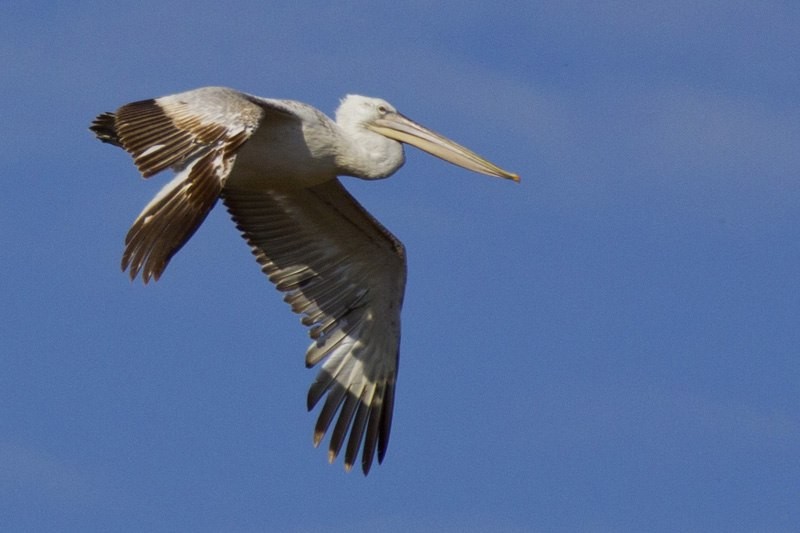Dalmatian Pelican
A species of Pelicans Scientific name : Pelecanus crispus Genus : Pelicans
Dalmatian Pelican, A species of Pelicans
Botanical name: Pelecanus crispus
Genus: Pelicans
Content
Description People often ask General Info
 Photo By Попов Евгений , used under CC-BY-SA-3.0 /Cropped and compressed from original
Photo By Попов Евгений , used under CC-BY-SA-3.0 /Cropped and compressed from original Description
This huge bird is by a slight margin the largest of the pelican species and one of the largest living flying bird species. It measures 160 to 183 cm (5 ft 3 in to 6 ft 0 in) in length, 7.25–15 kg (16.0–33.1 lb) in weight and 245 to 351 cm (8 ft 0 in to 11 ft 6 in) in wingspan. Its median weight is around 11.5 kg (25 lb), which makes it perhaps the world's heaviest flying bird species, although the largest individuals among male bustards and swans may be heavier than the largest individual Dalmatian pelican. More recently, six male Dalmatians were found to average 10.4 kg (23 lb) and four females 8.7 kg (19 lb), around the same average weight as the great white pelican (Pelecanus onocrotalus) and slightly lighter than mean body masses from other huge birds such as the trumpeter swan (Cygnus buccinator) or Andean condor (Vultur gryphus). A mean estimated body mass for the Dalmatian pelican of 10.9 kg (24 lb) was also published, around the same mass as the aforementioned largest swan and condor. It is either the heaviest or one of the heaviest birds native to Europe, its closest rival in mass being mute swans (Cygnus olor), which weighs on average around 10.1 kg (22 lb), followed closely by the cinereous vulture (Aegypius monachus) (whose average weight is not known) and the whooper swans (Cygnus cygnus), averaging at just shy of 9.5 kg (21 lb), and the great white pelican. These same five species are probably rank as the largest flying birds in Asia as well, alongside the Himalayan vulture (Gyps himalayensis). It also appears to have one of the largest wingspans of any living bird, rivaling those of the great albatrosses (Diomedea ssp., in particular the two largest species, the wandering albatross and southern royal albatross) and the great white pelican. These four species are the only modern birds with verified wingspans that range over 350 cm (11 ft 6 in). The somewhat similar-looking great white pelican broadly overlaps in size but has greater size sexual dimorphism: female great whites can be noticeably smaller than female Dalmatians but male individuals of the two species are essentially the same size and weight. However, the Dalmatian differs from this other very large species in that it has curly nape feathers, grey legs and silvery-white (rather than pure white) plumage. In winter, adult Dalmatian pelicans go from silvery-grey to a dingier brownish-grey cream colour. Immature birds are grey and lack the pink facial patch of immature white pelicans. The loose feathers around the forehead of the Dalmatian pelican can form a W-like-shape on the face right above the bill. In the breeding season it has an orange-red lower mandible and pouch against a yellow upper mandible. In winter, the whole bill is a somewhat dull yellow. The bill, at 36 to 45 cm (14 to 18 in) long, is the second largest of any bird, after the Australian pelican (Pelecanus conspicillatus). The bare skin around the eye can vary from yellow to purplish in colour. Among standard measurements, compared to the great white pelican, the Dalmatian's tarsus is slightly shorter, at 11.6 to 12.2 cm (4.6 to 4.8 in), but its tail and wing chord length are notably larger, at 22 to 24 cm (8.7 to 9.4 in) long and 68 to 80 cm (27 to 31 in), respectively. When the Dalmatian pelican is in flight, unlike other pelicans, its wings are solid grayish-white with black tips. It is an elegant soaring bird. When a whole flock of Dalmatian pelicans is in flight, all its members move in graceful synchrony, their necks held back like a heron's. The Dalmatian pelican is often silent, as most pelicans tend to be, although it can be fairly vocal during the mating season, when it may engage in a wide range of guttural, deep vocalisations, including barks, hisses and grunts. 
Size
1.8 m
Nest Placement
Ground
Feeding Habits
Dalmatian Pelican primarily consumes fish, such as carp, perch, and pike, requiring 1,200 g daily. They forage solo or in small groups, swimming and scooping prey with their pouch. Dalmatian Pelican occasionally eats crustaceans, worms, and small birds, and may store fish in its pouch for later.
Habitat
Dalmatian Pelican typically inhabits a variety of wetland environments, including lakes, rivers, deltas, and estuaries. Unlike some related species, dalmatian Pelican is not restricted to lowland wetlands and may breed at various elevations, often favoring traditional breeding sites. They construct nests on islands or within dense aquatic vegetation such as expansive reedbeds. In winter, dalmatian Pelican can be found on ice-free European lakes or on seasonal Indian lakes known as jheels, and sometimes along sheltered inshore coastal areas for feeding.
Dite type
Piscivorous
People often ask
General Info
Feeding Habits
Bird food type
Distribution Area
The Dalmatian pelican is found in lakes, rivers, deltas and estuaries. Compared to the great white pelican, the Dalmatian is not as tied to lowland areas and will nest in suitable wetlands with many elevations. It is less opportunistic in breeding habitat selection than the great white, usually returning to a traditional breeding site year after year unless it becomes completely unsuitable. During the winter, Dalmatian pelicans usually stay on ice-free lakes in Europe or jheels (seasonal lakes) in India. They also visit, typically during winter, inshore areas along sheltered coasts for feeding. 
Species Status
Not globally threatened.
Scientific Classification
Phylum
Chordates Class
Birds Order
Pelicans and Relatives Family
Pelicans Genus
Pelicans Species
Dalmatian Pelican